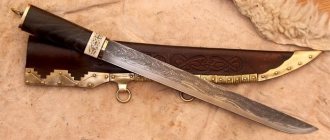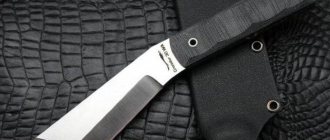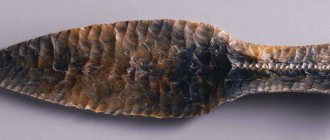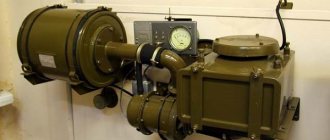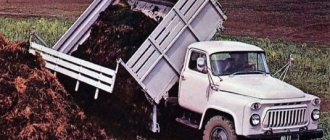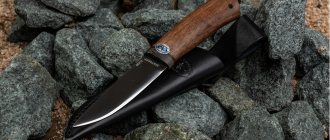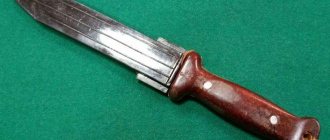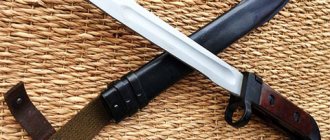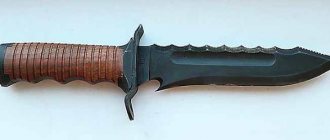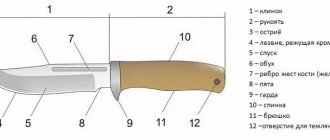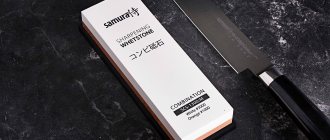Very often, hunters, tourists, fishermen and many who like to actively spend their holidays ask the question: “How to successfully choose a bladed weapon?” In this case, preference is given mainly to proven brands. One of them is the American brand “Cabar”. A knife manufactured under this brand was once very popular among infantrymen and US Navy personnel. Today it is no less in demand among the civilian population.
Wartime developments
During the war with the Japanese, the issue of supplying American infantrymen with high-quality combat knives became especially acute. In tropical jungle conditions, the use of existing bayonets turned out to be ineffective. The US Army needed full-fledged knives. Manufacturers of edged weapons, developing a joint action plan, decided that the new knife should not differ from the models already in use. It was also decided that the blades would be made of high-carbon steel, and the handles and sheaths would be leather. The military command was presented with several design options for future edged weapons. Preference was given to the sample that was proposed. The knife was first tested by Marines who had returned from Guadalcanal by that time.
Where is it used in peacetime?
Previously, the Kabar knife was used exclusively by the American military to perform specific tasks. However, with the end of hostilities, high-quality knives found use in peaceful life.
This weapon is used by extreme tourists who want to test their strength in the fight against nature. Kabar knives are especially popular among:
- hunters and fishermen;
- rock climbers;
- extreme tourists;
- collectors.
Kabar knife and case for it.
For many representatives of the stronger sex, such a knife would be an excellent gift. The Kabar knife is perfect for those who are planning a hike in places far from civilization. With it you can:
- open a can of canned food;
- cut up the carcass;
- prepare wood for lighting a fire;
- defend yourself in a fight with a wild animal;
- Make it easier for you to set up camp.
Who made the knives?
Small batches of combat blades received for American infantry were hastily tested. This was followed by a large order for 200 thousand units, produced by such well-known American knife manufacturers as Boker, Camillus, Case, Pal and Kabar. The knife has official names:
- Mark II (naval version);
- USMC (Infantry).
It was originally planned that special stamps would be applied to the blades, indicating the name of the manufacturer and military unit. Since this significantly complicated the processes of manufacturing and storing products, it was decided to abolish the practice of stamping. Only the designations have been preserved: United Cutlery and "Cabar". The knife under this name became famous among the American Marines. Manufacturer United Cutlery has produced over a million of these blades.
The Second World War
After the United States entered World War II, soldiers had a number of complaints and complaints about the knives they used. The Mark I was expensive and labor-intensive to produce, and the relatively thin blade of the Mark I was easy to break when performing common household tasks such as cutting wire or opening boxes of ammunition and dry rations. The final decision on the need to develop a new multi-purpose knife for combat and domestic tasks was made by the military department.
The Marine Corps has authorized limited issue of a combat knife with a stiletto blade designed by Marine Corps engineer officer Lt. Col. Clifford Huey. The Marine Raider was originally issued to elite naval units. Marines found that the Marine Raider was good for silent killing, but too fragile for everyday tasks.
In the absence of suitable official knives, some Marines, before combat in 1942, privately purchased hunting or utility models. The most popular pre-war knives were the L76 and L77. Both had 7-inch (18 cm) blades and had leather stacked handles.
In response to a specification requiring the development of a modern Marine custom combat knife, officers requested input from several military tool suppliers to develop a suitable prototype using the US Navy Mark 1 service knife and an existing hunting knife, the L77, as the basis for further improvements. Working with Union Cutlery, Colonel John M. Davis and Major Howard E. America made several important changes: a longer, reinforced blade, the introduction of a small fuller, a pommel that was pinned through the tang, a straight (later slightly curved) steel guard, and inlaid leather handle for better grip. The blade and all metal parts were given a matte black finish instead of the polished steel of the original prototype. The coating protected the knife from rust and made it more secretive, since the possibility of glare in the sun was almost completely eliminated. The Marine Corps accepted Ka-Bar on November 23, 1942.
The Ka-Bar proved to be easy to manufacture, with the first production release being shipped by the Camillus Cutlery Company on January 27, 1943. After the US Navy became disillusioned with the USN Mark 1 knife, the Ka-Bar was adopted as the US Utility Knife, Mark 2. In naval service, the knife was used for diving and utility tasks from late 1943, although the stacked leather handle, as a rule, they rotted and quickly became unusable due to exposure to salt water.
At the end of 1943, the Ka-Bar replaced the stiletto - the Marine Raider. Colonel Edson considered the stiletto ideal for combat missions, but of little use for anything else. By 1944, the Ka-Bar was issued to virtually all combat squad Marines who wanted it. The knife was used by instructors to train recruits. Unlike the previous Marine Raider, Marines began to be taught to use the new knife primarily as a slashing weapon.
As its new name, the "Fighting Utility Knife" suggested, was designed with two primary uses: it was an effective combat knife and a utilitarian tool well suited to the jungle warfare that Marines faced. The controversial designation led to initial criticism of the knife, but the combat experience of returning veterans, as well as reports from the battlefield, soon dispelled any doubts about its combat effectiveness.
How does the Kabar tactical knife work?
The blades were made in several variations. They differed from each other in the way the heel was fastened. The first version of the knife turned out to be not perfect enough, and they decided to replace it. Often the blades broke. Since this happened in the part where they have a stamp, there was an opinion that the stamping procedure affected the fracture. It was decided to move him to the guard. It soon became clear that the blade breakages had nothing to do with this. This already happened after the war. It was again decided to put the stamp on the “Kabar” knife. (A photo of this bladed weapon is presented in the article).
When making blades, some manufacturers used the bluing procedure, while others used parkerization, a type of bluing. In this case, phosphoric acid and iron filings etched with it were used.
History of invention
The first Kabar knives began to be produced back in the 19th century. It was during that period that companies specializing in the production of kitchen utensils began operating in the United States of America.
Over time, they pushed the craftsmen aside, but they decided not to give up and set up their own production.
Where did the name bladed weapons come from?
The name of the brand Kabar arose by chance. It all started with receiving a letter in which the hunter thanked the company for producing such high-quality and reliable knives, because it was with the help of their product that he saved himself in a fight with a bear.
Moreover, the letter was written with a huge number of errors and in poor English, so the phrase kill a bear (in English “kill a bear”) was written as “Ka bar”. The employees really liked such a simple term and over time this phrase was used for the brand name.
Who made knives
The headquarters of this enterprise was located in Pennsylvania, and the company was called Tidioute Cutlery Company. Then its founders planned to produce cutlery.
Since the beginning of the twentieth century, the company has expanded, and its products have become more and more in demand every year. The plant's capacity was no longer sufficient to meet demand, so a plant was opened in Olin (New York). Over time, the plant in Pennsylvania was liquidated, and all efforts were spent on expanding the new plant.
Wartime developments
At the height of World War II, units of American fighters were supplied with the Kabar knife. The first models of the gun were manufactured in 1942 and were called USN Fighting Knife MARK2 .
The military appreciated the advantages of knives, as they were distinguished by their reliability and simplicity. There were also models for the navy, but their number was limited, while army models were produced until 1980.
Wartime knife Kabar.
In 1995, the appearance of the knife was changed; this modification was called the “next generation”. However, production was stopped already in 2012, as preference was given to old, proven models.
Ka-Bar Tanto Black 600
The blade of this combat knife has a special plasma-ceramic coating. Melee weapons are equipped with a one-sided sharpening. There is a partial serrated on the cutting edge of the blade. Titanium is used to make the guard. Especially for ease of wearing, the designers have provided a hole for a lace in the guard. The handle of the knife is kratan. This melee weapon is especially effective when delivering cutting blows. The size of the knife is 300 mm, the blade is 160 mm. The knife weighs 310 grams.
Distinctive qualities
What does a “Kabar” (knife) look like? The photos presented in the material allow us to form a general idea of the shape of such weapons. The model is distinguished by a slight but well-sharpened bevel of the butt. Blood flow is used as an element to maintain optimal balance.
The “Kabar” (knife) is made from shock-resistant carbon steel, which is sharpened to a razor sharpness. For fine figured wood carving, such a product is most likely not suitable due to its rather massive size. However, the Kabar knife stabs and chops excellently.
Products in this category are designed, first of all, to deliver strong blows, which, in fact, is what the military most often needs. Moreover, such knives pierce almost everything in their path.
Product USMC
"Kabar" is considered the most common army edged weapon. The combat knife was very popular among American infantrymen during World War II. The blade is equipped with a one-and-a-half-sided sharpening. Steel was used in the manufacture of the guard and pommel. The handle is leather inlaid. The size of the bladed weapon is almost 30 cm. The blade length is 178 mm. The knife weighs 320 grams. The product comes with a sheath made of leather. The USMC Blade is the official World War II memorial knife of the American Marine Corps.
Main characteristics
When we talk about the technical characteristics of the Kabar knife, we are talking about the classic model manufactured by United Cutlery. Among the main characteristics it is worth noting:
- gun weight 560 grams;
- total length 30.8 cm;
- blade length 17.7 cm;
- maximum blade width 3.2 cm;
- thickness at the butt 4.2 cm;
- hardness ranges from 56 to 58 units.
The blade was made from durable steel, which ensures a long service life of the tool and its reliability in any situation. The handle consists of several oval-shaped rings made from genuine leather.
The pommel was made of metal, which ensured the strength of the structure. The guard is made of steel and has a slight bend.
